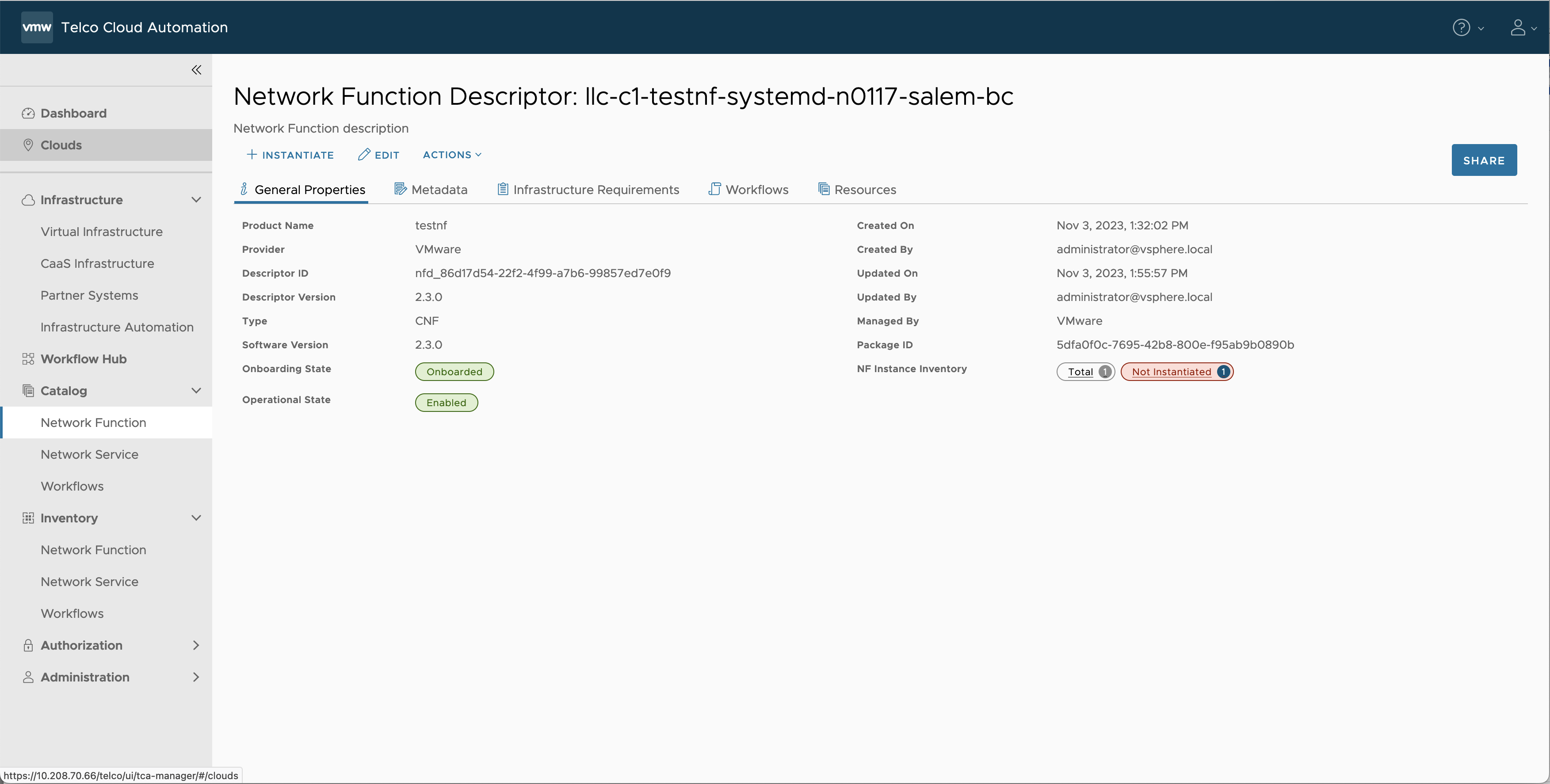In LLS-C1 configuration, the DU operates PTP in T-BC mode, sourcing the network time from a Precision Real-Time-Clock/Telecom Grandmaster (PRTC/T-GM) in Midhual. When PTP runs in T-BC mode, one port functions as a Client to a remote PRTC/T-GM and other ports function as Servers, providing time to downstream devices.
In the following example topology, PF0 on the DU receives time from the Cell Site Router (CSR) functioning as T-GM and distributes time to the RUs connected on PF1 and PF3.

Procedure
- Navigate to Catalog > Network Function in the Telco Cloud Automation UI.
- Select the Network Function you want to set up in T-BC mode and click EDIT.
- Click the Infrastructure Requirements tab.
- Add PTP devices under PCI PASS THROUGH:
- Click ADD and select PTP from the drop-down list.
- In the Add PTP pop-up window, select PTP as the Device Type.
- Enable or disable Shared Across NUMA as required.
- Enter the name of the PF Group, the PCI Group that you created in the Host Profile. Example: ptp-h0915
- Enter the Interface Name you want to create for this PTP Device on the worker node. Example: ptp-h0915
- Click ADD.
- Repeat steps a-f for each PTP device you want to add.
Note: When you add one or more PTP Devices, an entry for 'linuxptp' gets created in the Custom Packages section. Modify the linuxptp version as required.

- Click the Resources tab.
- Expand the Artifacts > scripts directory.
- Add the following configuration files by clicking the + symbol next to 'scripts':
-
phc2sys
OPTIONS="-s ptp -c CLOCK_REALTIME -O -37 -m"

ptp4l
OPTIONS="-f /etc/ptp4l.conf"
ptp4l.conf
Note: This sample configuration file is valid for linuxptp version 4.0-2.ph3
[global]
#
# Default Data Set
#
twoStepFlag 1
clientOnly 0
socket_priority 0
priority1 128
priority2 128
domainNumber 24
#utc_offset 37
clockClass 248
clockAccuracy 0x21
offsetScaledLogVariance 0xFFFF
free_running 0
freq_est_interval 1
dscp_event 0
dscp_general 0
dataset_comparison G.8275.x
G.8275.defaultDS.localPriority 128
maxStepsRemoved 255
#
# Port Data Set
#
logAnnounceInterval -3
logSyncInterval -4
operLogSyncInterval 0
logMinDelayReqInterval -4
logMinPdelayReqInterval 0
operLogPdelayReqInterval 0
announceReceiptTimeout 3
syncReceiptTimeout 0
delayAsymmetry 0
fault_reset_interval 4
neighborPropDelayThresh 20000000
serverOnly 0
G.8275.portDS.localPriority 128
asCapable auto
BMCA ptp
inhibit_announce 0
inhibit_delay_req 0
ignore_source_id 0
#
# Run time options
#
assume_two_step 0
logging_level 6
path_trace_enabled 0
follow_up_info 0
hybrid_e2e 0
inhibit_multicast_service 0
net_sync_monitor 0
tc_spanning_tree 0
tx_timestamp_timeout 300
unicast_listen 0
unicast_master_table 0
unicast_req_duration 3600
use_syslog 1
verbose 0
summary_interval 0
kernel_leap 1
check_fup_sync 0
#
# Servo Options
#
pi_proportional_const 0.0
pi_integral_const 0.0
pi_proportional_scale 0.0
pi_proportional_exponent -0.3
pi_proportional_norm_max 0.7
pi_integral_scale 0.0
pi_integral_exponent 0.4
pi_integral_norm_max 0.3
step_threshold 0.0
first_step_threshold 0.00002
max_frequency 900000000
clock_servo pi
sanity_freq_limit 200000000
ntpshm_segment 0
msg_interval_request 0
servo_num_offset_values 10
servo_offset_threshold 0
write_phase_mode 0
#
# Transport options
#
transportSpecific 0x0
ptp_dst_mac 01:1B:19:00:00:00
p2p_dst_mac 01:80:C2:00:00:0E
udp_ttl 1
udp6_scope 0x0E
uds_address /var/run/ptp4l
uds_ro_address /var/run/ptp4lro
#
# Default interface options
#
clock_type BC
network_transport L2
delay_mechanism E2E
time_stamping hardware
tsproc_mode filter
delay_filter moving_median
delay_filter_length 10
egressLatency 0
ingressLatency 0
boundary_clock_jbod 1
#
# Clock description
#
productDescription ;;
revisionData ;;
manufacturerIdentity 00:00:00
userDescription ;
timeSource 0x20
# Name of the interface which is getting
# PTP packets from the network.
[ptp]
serverOnly 0
# interface's connected to RUs
[ptp-h0915]
serverOnly 1
Note: In the following ptp4l.conf file content, you can notice the interface name that you added in Step #4. In this example, only one RU is connected, so there is only one entry 'ptp-h0915'. If multiple RUs are connected, you need an entry for each RU (similar to ptp-h0915).

- Save the CSAR by clicking SAVE.
- Click UPDATE PACKAGE or SAVE AS NEW as appropriate.
- Click CLOSE.
- Instantiate the network function.







